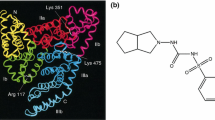Abstract
Kinetics of fatty acid binding ability of glycated human serum albumin (HSA) were investigated by fluorescent displacement technique with 1-anilino-8-naphtharene sulphonic acid (ANS method), and photometric detection of nonesterified-fatty-acid (NEFA method). Changing of binding affinities of glycated HSA toward oleic acid, linoleic acid, lauric acid, and caproic acid, were not observed by the ANS method. However, decreases of binding capacities after 55 days glycation were confirmed by the NEFA method in comparison to control HSA. The decrease in binding affinities was: oleic acid (84%), linoleic acid (84%), lauric acid (87%), and caproic acid (90%), respectively. The decreases were consistent with decrease of the intact lysine residues in glycated HSA. The present observation indicates that HSA promptly loses its binding ability to fatty acid as soon as the lysine residues at fatty acid binding sites are glycated.
Similar content being viewed by others
References
Arai K, Maguchi S, Fujii S, Ishibashi H, Oikawa K and Taniguchi N 1987 Glycation and inactivation of human Cu-Zn-superoxide dismutase. Identification of thein vitro glycated sites;J. Biol. Chem. 262 16969–16972
Ashbrook J D, Spector A A, Santos E C and Fletcher J E 1975 Long chain fatty acid binding to human plasma albumin;J. Biol. Chem. 250 2333–2338
Bailey A J, Robins S P and Tanner M J 1976 Reducible components in the proteins of human erythrocyte membrane;Biochim. Biophys. Acta 434 51–57
Bhattacharya A A, Grune T and Curry S 2000 Crystallographic analysis reveals common momdes of binding of medium and long-chain fatty acid to human serum albumin;J. Mol. Biol. 303 721–732
Bidlingmeyer B A, Cohen S A and Tarvin T L 1984 Rapid analysis of amino acids using pre-column derivatization;J. Chromatogr. 336 93–104
Brownlee M and Cerami A 1981 The biochemistry of the complications of diabetes mellitus;Annu. Rev. Biochem. 50 385–432
Brownlee M, Cerami A and Vlassara H 1988 Advanced glycosylation end products in tissue and the biochemical basis of diabetic complications;N. Engl. J. Med. 318 1315–1321
Chavez J A, Holland W L, Bar J, Sandhoff K and Summers S A 2005 Acid ceramidase overexpression prevents the inhibitory effects of saturated fatty acids on insulin signaling;J. Biol. Chem. 280 20148–20153
Chen R F 1967 Removal of fatty acids from serum albumin by charcoal treatment;J. Biol. Chem. 242 173–181
Duncombe W G 1964 The colorimetric micro-determination of non-esterified fatty acids in plasma;Clin. Chim. Acta 9 122–125
Figge J, Rossing T H and Fencl V 1991 The role of serum proteins in acid-base equilibria;J. Lab. Clin. Med. 117 453–467
Garlick R L and Mazer J S 1983 The principal site of nonenzymatic glycosylation of human serum albumin;J. Biol. Chem. 256 6142–6146
Iberg N and Flückiger R 1986 Nonenzymatic glycosylation of albuminin vivo. Identification of multiple glycosylated sites;J. Biol. Chem. 261 13542–13545
Kashyap S R, Belfort R, Berria R, Suraamornkul S, Pratipranawatr T, Finlayson J, Barrentine A, Bajaj M, Mandarino L, DeFronzo R and Cusi K 2004 Discordant effects of a chronic physiological increase in plasma FFA on insulin signaling in healthy subjects with or without a family history of type 2 diabetes;Am. J. Physiol. Endocrinol. Metab. 287 537–546
Lee I Y and McMenamy R H 1980 Location of the medium chain fatty acid site on human serum albumin. Residues involved and relationship to the indole site;J. Biol. Chem. 255 6121–6127
Lopaschuk G D 2002 Metabolic abnormalities in the diabetic heart;Heart Fail Rev. 7 149–159
Lyons T J, Silvestri G, Dunn J A, Dyer D G and Baynes J W 1991 Role of glycation in modification of lens crystallins in diabetic and nondiabetic senile cataracts;Diabetes 40 1010–1015
McGarry J D 2002 Banting lecture 2001: dysregulation of fatty acid metabolism in the etiology of type 2 diabetes;Diabetes 51 7–18
Murtiashaw M H and Winterhalter K H 1986 Non-enzymatic glycation of human albumin does not alter its palmitate binding;Diabetologia 29 366–370
Peters T Jr 1985 Serum albumin;Adv. Protein Chem. 37 161–245
Reed R G 1986 Location of long chain fatty acid-binding sites of bovine serum albumin by affinity labeling;J. Biol. Chem. 261 15619–15624
Shaklai N, Garlick R L and Bunn H F 1984 Nonenzymatic glycosylation of human serum albumin alters its conformation and function;J. Biol. Chem. 259 3812–3817
Shapiro R, McManus M J, Zalut C and Bunn H F 1980 Sites of nonenzymatic glycosylation of human hemoglobin A;J. Biol. Chem. 255 3120–3127
Spector A A and Hoak J C 1969 An improved method for the addition of long-chain free fatty acid to protein solutions;Anal. Biochem. 32 297–302
Takikawa H and Kaplowitz N 1986 Binding of bile acids, oleic acid, and organic anions by rat and human hepatic Z protein;Arch. Biochem. Biophys. 251 385–392
Unger R H 2002 Lipotoxic diseases;Annu. Rev. Med. 53 319–336
Waldmann T A 1977 Albumin catabolism; inAlbumin structure, function and uses (eds) V M Rosenoer, M Rats and M A Rothschild (Oxford: Pergamon) pp 255–273
Watkins N G, Thrope S R and Baynes J W 1985 Glycation of amino groups in protein. Studies on the specificity of modification of RNase by glucose;J. Biol. Chem. 260 10629–10636
Author information
Authors and Affiliations
Corresponding author
Rights and permissions
About this article
Cite this article
Yamazaki, E., Inagaki, M., Kurita, O. et al. Kinetics of fatty acid binding ability of glycated human serum albumin. J. Biosci. 30, 475–481 (2005). https://doi.org/10.1007/BF02703721
Received:
Accepted:
Published:
Issue Date:
DOI: https://doi.org/10.1007/BF02703721




